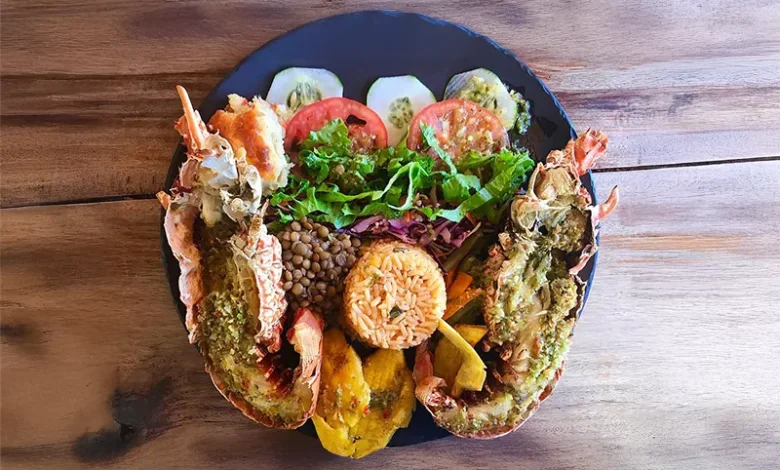Dominica’s Culinary Heritage

Dominica’s Culinary Heritage is a rich and dynamic expression of the island’s cultural mosaic, where food nourishes and tells stories of history, resilience, and adaptation. Woven from Kalinago, African, European, and East Indian influences, the island’s cuisine reflects centuries of migration, colonisation, enslavement, and cultural fusion. Dominican food is as diverse and storied as its people, from smoked fish and roasted breadfruit to cassava bread and coconut milk stews.
Culinary History and Cultural Influences
Dominica’s earliest food traditions began with the Kalinago, the island’s Indigenous people, who practised sustainable agriculture, fishing, and foraging. Their use of root crops like dasheen, tannia, yam, sweet potato, and cassava formed the base of what would become national staples. Dishes like cassava bread and farine were common, along with smoked meats and fish cooked over open fires or in earth ovens.
With the arrival of European colonists and African slaves in the 17th century, new culinary traditions emerged. Africans brought one-pot cooking techniques and a deep knowledge of tropical agriculture, including the use of breadfruit, plantains, okra, and callaloo. Dishes like pelau, callaloo soup, fig and saltfish, and souse grew out of this influence. The African tradition of using seasoning herbs — including Coriander, thyme, green onions, garlic, and Scotch bonnet peppers — remains a cornerstone of Dominican cooking today.
French and British colonial rule introduced new ingredients, such as bay leaf, parsley, and basil, along with cooking methods like stewing, baking, and pastry-making. From the French came rich coq au vin-style chicken stews, while the British left behind their love for puddings, bakes, and porridge. Later, the East Indian community added dishes seasoned with turmeric, curry powder, and ginger — seen today in curried goat, roti, and chicken curry.
Key Traditional Dishes
Dominica’s culinary traditions are deeply tied to both daily sustenance and cultural celebrations. Meals are hearty and made with locally sourced ingredients — often organic, fresh, and seasonal due to the island’s fertile volcanic soil.
Some of Dominica’s most iconic dishes include:
- Mountain Chicken (Crapaud): Once considered a national delicacy, this dish is made from the endangered giant ditch frog, seasoned and fried or stewed. Now rarely consumed due to conservation efforts.
- Callaloo Soup: A thick green soup made with dasheen leaves, coconut milk, and smoked meat (including agouti, manicou) or crab.
- Saltfish and Green Fig: Boiled green bananas served with sautéed salted codfish, onions, and peppers — a national staple.
- Souse: A zesty preparation of pickled pig trotters or chicken feet with cucumber, onions, lime, and hot pepper.
- Bouyon: A thick, one-pot stew made with meat (often pork or beef), ground provisions, dumplings, and plantains.
- Cornmeal Pap: A breakfast porridge made with cornmeal, cinnamon, and nutmeg, sweetened with condensed milk.
Festive Foods and Culinary Events
Food is central to Dominica’s national celebrations and communal gatherings. During Creole Heritage Month, Jounen Kwéyòl, and Independence celebrations, traditional dishes take center stage, served at public events, homes, and cultural festivals across the island. At the Roseau Old Market, vendors sell local treats such as tamarin balls, cassava pone, coconut tablet, and bakes (fried dough).
The Waraka Séwinal Festival in the Kalinago Territory is another vibrant showcase of food, music, and ancestral traditions. Events like the National Cultural Gala and Community Day of Service promote traditional cooking as part of cultural preservation, often supported by institutions like the Division of Culture and the Ministry of Culture, Youth, Sports and Community Development.
Culinary Ingredients and Regional Variations
Dominica’s interior villages and coastal communities each boast distinct culinary styles. Inland regions like Belles, Laudat, and Grand Fond emphasize root vegetables, bush teas, and wild meat. Coastal villages such as Layou, Soufriere, and Portsmouth feature seafood heavily — from grilled snapper and lobster to octopus stew and fish broth.
Common ingredients across the island include:
- Ground provisions: Yam, tannia, dasheen, sweet potato, cassava
- Fruits: Golden apple, mango, guava, sour sop, passion fruit, starfruit
- Seasonings: Green seasoning, chadon beni, garlic, thyme, onion, hot pepper
- Coconut products: Grated coconut, coconut oil, and coconut milk used in stews, desserts, and drinks
Bush teas remain a staple in Dominica households, with medicinal blends made from bay leaf, cinnamon, ginger, lemongrass, zeb-a-pique, and cacao sticks — believed to support digestion, immunity, and general wellness.
Preservation and Culinary Identity
Today, Dominica’s culinary heritage is actively preserved and promoted through education, oral tradition, and national initiatives. Cooking classes, radio programs, community cook-offs, and festivals all play a role in maintaining this living legacy. Traditional recipes are being documented in cookbooks, digitized archives, and video tutorials to ensure they remain accessible to younger generations.
As globalization influences diets across the Caribbean, Dominica stands out for its continued reliance on local produce, home gardens, and communal knowledge. Food remains a powerful connection to ancestry, land, and cultural pride — a story told in every calabash bowl, every pot of bouyon, and every morning cup of bush tea.




